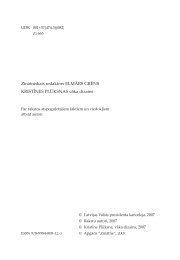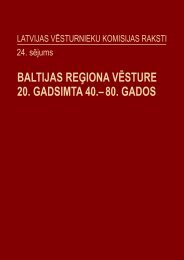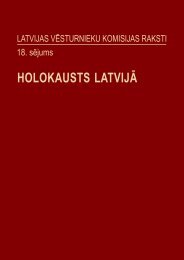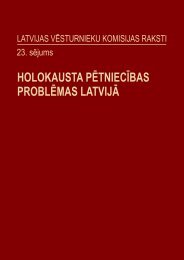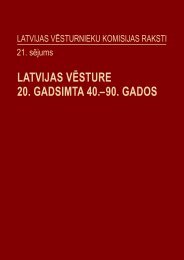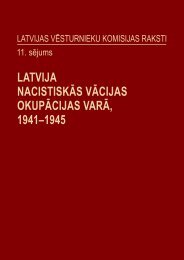15.sējums - Valsts prezidenta kanceleja
15.sējums - Valsts prezidenta kanceleja
15.sējums - Valsts prezidenta kanceleja
You also want an ePaper? Increase the reach of your titles
YUMPU automatically turns print PDFs into web optimized ePapers that Google loves.
38 Padomju okupācija 1940–1941<br />
destiny in Krušonys village, Kaišiadorys district, Trakai county. The total number of<br />
group slaughter amounts to almost 40. 35 The list of persons killed during the 23 June<br />
1941 rebellion contains 1,095 entries.<br />
Several weeks later, P. Gladkov wrote his report in which he remembered<br />
to mention that 4 detainees had been shot in Zarasai (and 4 stayed alive). 36 He also<br />
mentioned the shooting of 15 persons arrested in Panevėžys during the liquidation<br />
of a partisan platoon. In fact, 19 people were shot there. By contrast with other cases,<br />
this time there were witnesses to this massacre. One of them gave evidence that<br />
“a prison car and a lorry loaded with armed soldiers [..]” came to the scene of the<br />
execution, “the cars stopped by an open pit [..]. Then chekists opened the prison<br />
car, jumped into it and started throwing people into the pit. Chekists and senior<br />
political instructors fired shots at the thrown bodies. [..] This was completed very<br />
fast, in some 10 or 15 minutes.” 37 The massacre was committed on 25 June, at a<br />
distance of 300 to 400 metres from the sugar factory. 15 Kupiškis residents, who<br />
had been arrested in the Kupiškis district and brought to Panevėžys on the eve of<br />
the massacre, were among the victims (two others could not be identified because<br />
of severe wounds).<br />
In Panevėžys, the murders continued until the withdrawal of the Red Army troops.<br />
On 26 June in Panevėžys, in the cellar of the headquarters of the Read Army, three<br />
doctors from Panevėžys county were tortured to death in the most brutal manner:<br />
reservist Col. J. Žemgulys, A. Gudonis, S. Mačiulis. In the same cellar, nurse of the<br />
hospital Z. Kanevičienė and three other Panevėžys residents were executed.<br />
Massacre of the Militaries<br />
The remains of the Lithuanian Army were totally destroyed. On 22 June 1941, 7000–<br />
8000 Lithuanian soldiers served in the 29 territorial riflemen corps. 38 As the war began,<br />
Soviet troops besieged the camps of the divisions of the 29th territorial riflemen corps.<br />
A decree was issued stating that soldiers detained outside the camps would be handed<br />
in to the military tribunal and executed. The divisions were ordered to move towards<br />
the inland of Russia. The killing of Lithuanian soldiers was related both to the outbreak<br />
of the rebellion, and to the refusal to obey the orders of the Red Army commandment.<br />
Nevertheless, at the outset of the war, more than 5500 Lithuanian soldiers managed<br />
to fight their way out of the Soviet military control and stayed in Lithuania. In the<br />
course of their liberation, 120 soldiers perished or were missing: 1 lieutenant-colonel,<br />
3 majors, 8 captains, 8 lieutenants, 3 junior lieutenants, 6 cadets, 8 warrant officers,<br />
9 non-commissioned officers, 10 junior non-commissioned officers, 3 lance-corporals,



